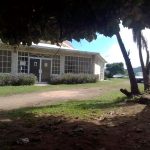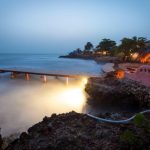
Geography: Jamaica is the third largest Caribbean island, measuring 146 miles at its widest point. Primarily of volcanic origin, the lush island features a mountain ridge that peaks at Blue Mountain which is 7,402 feet high. Many white-sand beaches and clear seas ring the island.
Population: The population of Jamaica was 2.4 million in 1990, with an average annual rate of growth of 1.1% from 1980 to 1990. Approximately 45% of the people are 19 years or under, and a little less than 8% are above 65. Based on the census of 1982, at least 48% of the population was urban; in 1943, the census estimated the urban population at that time to be 15%.
People: The people of Jamaica have emerged from a historical process in which peoples of all the continents were brought together within a well-defined social hierarchy. The vast majority are of African descent, but there are well established, but small, Indian, Chinese, Arab, and European communities as well. Jamaican culture is a particular synthesis of all these cultures. Popular culture is heavily influenced by the African heritage, while formal behavior is unmistakably British in style. While it is arguable that the popular speech of Jamaicans is a distinct language from English, it was derived largely from English which has been the official language for over 300 years. The influence of the USA is becoming more evident, reflecting the closer ties with that society.
Climate: In winter, the average temperature is 75 degrees; in summer it’s about 80. Year-round, temperatures are usually five to 10 degrees cooler in the mountain. Typically sunny year-round, Jamaica has rainy months in May, June, September and October. Jamaica’s 4-day weather forecast.
Currency: Goods and services are usually purchased in Jamaican dollars, although prices are sometimes posted in U.S. dollars, then converted. Credit cards are widely accepted.
Driving:Good roads and highways connect most of the vacation destinations. Remind clients to drive British-style, on the left side of the road. Also, drivers must learn to watch out for the many goats, bicyclists and pedestrians who also use the roads. Valid U.S. licenses are acceptable.
Time: Jamaica is on Atlantic Standard Time, which means that in summer it’s one hour behind Eastern Standard Time, and in winter it’s on EST. Check airline times.
Sports and Games:Golf, tennis, polo, bicycle racing, cricket, soccer, water-sports, horse racing, rafting and mountain climbing.
Food: A spicy, colorful mix of cuisine includes ackee and saltfish; rice and peas; jerk chicken, fish and pork; curried goat; pepperpot soup; roasted yams,; banana fritters; salads; fruits and exotic desserts. Take a look at Cook Jamaican.
Music: The country’s music consists of folk ballads, work songs, revivalist hymns and, of course, reggae.
Arts and crafts: Creations in straw, clay, fabric, shell, wood and semi-precious stone are on display at open-air markets and small galleries. Crafts are influenced by African, Indian, European and Arawak cultures. Depicting life and landscape, Jamaican paintings feature bright colors and bold lines.
Theater:From the 19th-century Ward Theater to innovative little theaters and thriving centers for drama in Kingston, Jamaica features a broad range of theatrical treats. Plays depict a variety of Jamaican experiences.
Religion: Christianity, in its various denominations, some indigenous, is the religion of the vast majority of Jamaicans. There are, however, other religions observed and practiced in Jamaica by relatively smaller numbers of people, such as Islam, Judaism, and Hinduism.
The people of Jamaica have emerged from a historical process in which peoples of all the continents were brought together within a well-defined social hierarchy.







